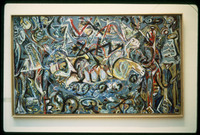Pasiphae
Pollock, Jackson

Download033238_cp.jpg (426.2Kb)
Alternative Titles
Pasiphaë
Moby Dick
Description
In terms of passion, inventiveness and emotional, violent energy, Pollock painted the strongest atavistic images of the '40s. His painting Pasiphae (1943) is an example of what was to come later––Pasiphae being, in Greek mythology, the wife of Minos and mother of the Minotaur by a white bull belonging to Minos.
Pasiphae's totemic image and mythic theme reflected Pollock's involvement in Jungian psychoanalysis, which emphasized archetypes and the "collective unconscious." Pollock, painter Mark Rothko and other Abstract Expressionists of the 1940s turned to archaic myths and primitive art for inspiration. These painters also developed the technique of automatism, or automatic or unconscious action, in psychological terms. Supposedly, automatism recollected man's primordial past and revealed the archetypal symbols that "lived" in the collective unconscious. As art historian Irving Sandler writes in American Art in the 20th Century (Prestel, 1993)
from http://www.gadflyonline.com/9-10-01/film-pollock.HTML
accessed 6/17/2004 full view
Type of Work
Oil paintingSubject
Dante Alighieri, 1265-1321, Ovid, 43 B.C.-17 or 18 A.D., Queens, Painting, Abstract, Minos (Legendary character), Minotaur (Greek mythology), Abstract expressionism, Pasiphae (Greek mythology), Painting, American --20th century, Art, Modern --20th century
Rights Statement
All rights reserved
Item is Part of
109747